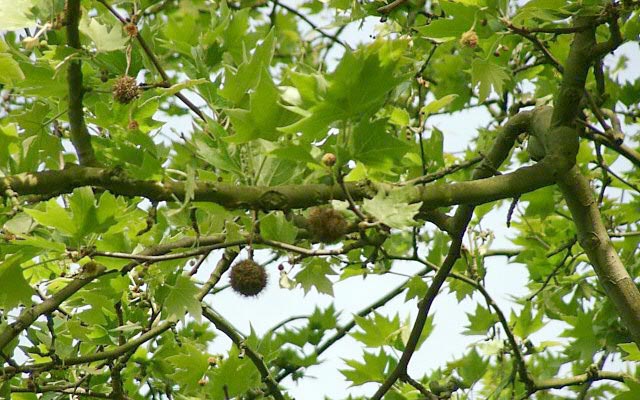The majestic plane tree
We discover the beauty of the mighty plane tree with Noel Kingsbury.


As the men working on the trees get closer, the noise they make gets louder and louder. Close by, the sound of their shredder is almost deafening and, not surprisingly, the men all wear hearing protection. The whine of several power saws, their tone varying depending on whether they are actively cutting wood or just turning over, provides an almost melodic background. Welcome to the very noisy world of urban tree pruning.
This scene can take place almost anywhere and is a vital one for shaping and controlling urban trees. Although limes are often shaped, pruning is most effective and most often seen applied to plane trees. Once complete, the effect is visually quite brutal, with the old growth ending in gaunt stumps. Come the spring, however, recovery is quick, with a host of new shoots and leaves emerging rapidly.
Plane trees respond very well to hard pruning and can be shaped and sized according to the space available and the function they serve. Tall pollards may line roads, while in town squares pleached planes may screen the houses around the edge from the public space in the centre; in the yards of cafés they may be trained horizontally in order to provide shade.
The plane tree may be remarkably tractable, but it grows vastly when left uncut. It can also live an immensely long time. One tree in the disputed territory of Nagorno-Karabakh, lying within Azerbaijan in the Caucasus, is thought to be more than 2,000 years old and is so big that it can accommodate 100 people inside its hollow trunk. Given its size, it is not surprising that the tree has acquired a spiritual value, with particular venerable specimens being made into shrines or associated with historic personalities or events.
A number of particularly majestic trees in the colleges of Cambridge University are thought to have been grown from seed collected on the battlefield of Thermopylae by a fellow of the university. One of these trees, at Emmanuel College, has begun to drape the ground with its branches, a habit that has been observed in a number of other venerable specimens. The branches then can even root and form new trees. A tree actually doing just this may be seen at Blickling Hall, in Norfolk; this particular specimen is thought to be around 250 years old.
When the plane was introduced to central and northern Europe from the 17th century onwards, it found a wide application in built-up environments. However, the plane most familiar to people living in cities is not P. orientalis but a hybrid between P. orientalis and P. occidentalis, a very similar tree from the eastern half of North America. The hybrid, P. x hispanica, is hardy and very tolerant of atmospheric pollution and root compaction.
During the late 18th and early 19th centuries, as modern notions of planning began to replace the chaotic street layouts of medieval cities, it was seized upon as an ideal urban tree. It was not only tolerant of pollution, but also less prone to the anthracnose fungal disease that afflicts P. orientalis. Like its parent, the hybrid could be treated as a majestic tree for large city squares, or kept trim and pollarded for tighter spaces. It was widely used in London, and its survival in the very polluted atmosphere of that city from the late 19th to the mid 20th century earned it the epithet of ‘London plane’. It is also found in elegant, 18th-century areas of other British cities, such as Bath and Edinburgh, complementing their austerely beautiful Georgian architecture.
Sign up for the Country Life Newsletter
Exquisite houses, the beauty of Nature, and how to get the most from your life, straight to your inbox.
P. x hispanica is not without its disadvantages. The young leaves and seed heads (that form distinct pendent bobbles in late summer) release large quantities of fluff. At the end of the year, the leaves are coarse and too tough to rot down quickly. Even so, this majestic and flexible hybrid continues to be planted, and remains the tree most closely associated with wellplanned city environments.
Extract from The Splendour of the Tree: An Illustrated History by Noel Kingsbury, with photography by Andrea Jones. Published by Frances Lincoln, £25
Four plants for £30 - Get four mixed hardy plants, selected for you from the Country Life nursery and delivered to your door, for £30. Visit www.countrylife.co.uk/nursery for your special offer.

Country Life is unlike any other magazine: the only glossy weekly on the newsstand and the only magazine that has been guest-edited by HRH The King not once, but twice. It is a celebration of modern rural life and all its diverse joys and pleasures — that was first published in Queen Victoria's Diamond Jubilee year. Our eclectic mixture of witty and informative content — from the most up-to-date property news and commentary and a coveted glimpse inside some of the UK's best houses and gardens, to gardening, the arts and interior design, written by experts in their field — still cannot be found in print or online, anywhere else.
-
 Six rural properties with space, charm and endless views, as seen in Country Life
Six rural properties with space, charm and endless views, as seen in Country LifeWe take a look at some of the best houses to come to the market via Country Life in the past week.
By Toby Keel
-
 Exploring the countryside is essential for our wellbeing, but Right to Roam is going backwards
Exploring the countryside is essential for our wellbeing, but Right to Roam is going backwardsCampaigners in England often point to Scotland as an example of how brilliantly Right to Roam works, but it's not all it's cracked up to be, says Patrick Galbraith.
By Patrick Galbraith